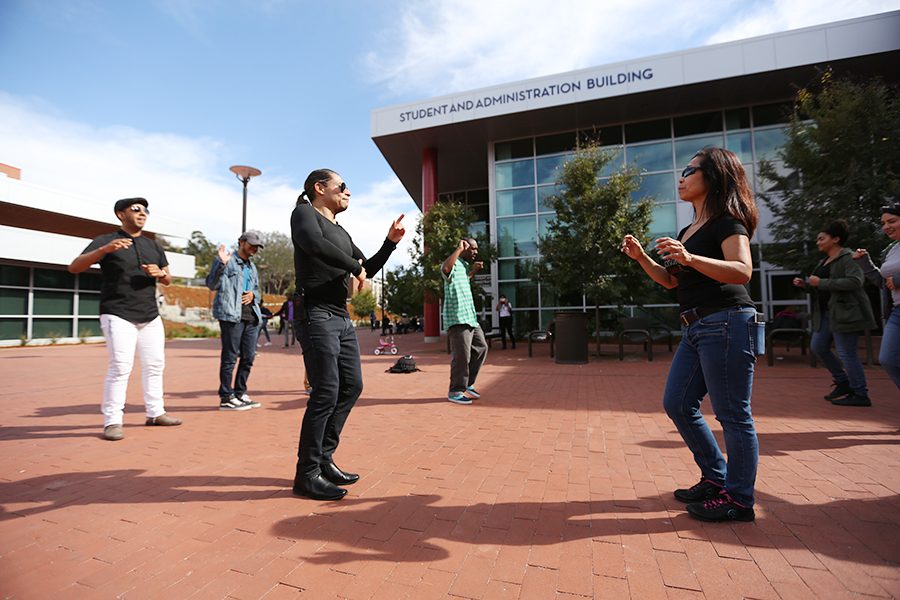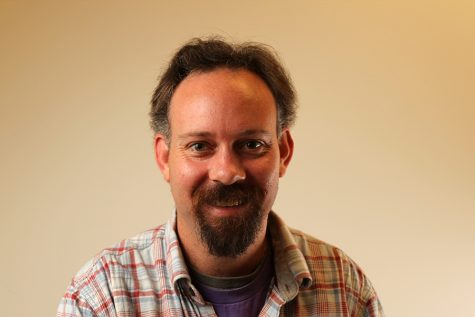Bachata on the Yard promotes Latin culture
Zumba instructor Oscar Ivan Solano (left) and chemistry professor Seti Sidharta (right) demonstrate dance moves during the Bachata on the Yard event in the Campus Center Plaza on Oct. 12.
Oct 21, 2016
Students trickled into the center of campus to tap their feet to the sound of music during Bachata on the Yard to learn the dance that came all the way from the Dominican Republic.
Certified Zumba instructor Oscar Ivan Solano taught free bachata dance lessons on Oct. 12 from 1 to 3 p.m. between Aqua Terra and Fireside Hall, which gave Contra Costa College students a taste of some Latin style.
“Latin people come from many different places, so we wanted to bring culture. We are being really active by bringing in various activities related to culture,” La Raza Student Union President Ricardo Sanchez said.
The purpose of the event was for students to be more active and develop an appreciation for dance during October, which is Hispanic Heritage Month, he said. Student Life Coordinator Joel Nickelson-Shanks teamed up with Solano to plan it.
ASolano said what makes bachata fun is that it contains music from different genres, so it provides an opportunity for people to dance at different speeds.
Solano said it’s a way to “court a partner,” and a way to find a significant other. Anyone was welcome to join the dance group from 1 to 3 p.m. and students from La Raza tapped their toes to the sound of the music thumping through the speakers.
Bachata originated in the Dominican Republic at the beginning of the 20th century, where it started out as a mix of bolero music with traditional African elements, and was a breath of fresh air for the people who lived on the island, according to mydanceproductions.com.
Solano then had the men pair up with the women and he played the first song for them to dance to — a simple-sounding beat that consisted of all original bachata drums. The basics of bachata are simple and include a one, two, three step with a tap from the opposite foot.
Then after moving to the right, both partners move to the left for a five, six, seven, tap. The man steps back with his right foot and moves to the left, with the woman stepping forward with her left and moving to her right. Later, Solano showed the students how to incorporate a spin in the routine. Both partners raise hands and the woman cups her right hand like a pair of scissors over the man’s left index and middle fingers, while the man’s right hand is lightly touching her elbow.
The woman lightly loosens her grip and slides her hand around the man’s two fingers, and they meet facing each other.
Biomedical engineering major Karla Cortes said, “After a day full of stressful classes, you are able to come out here and let loose, and it’s good to break away from academics for a little bit.”
She said she grew up dancing her whole life and got experience at family parties dancing bachata, cumbia and salsa.
“You can learn from other people and pick it up right away,” she said.
Chemistry professor Seti Sidharta invited the students from her class and the Center for Science Excellence program to join the fun event and learn about Latin culture through bachata music and dance. Nutritional science major Katherine Guevara said, “It’s always good to observe students from different cultures trying something new.”
She said she was raised in Spain but later moved to Colombia. Guevara said in Colombia, the dance scene is more salsa-centered, so naturally, she danced more salsa, but in Spain she grew up with more Dominicans, so she danced more bachata.
Child development major Lizeth Ceja said, “He’s a good teacher, and I like him because he engages students in current music.” She said that Solano has style that easily gets students enthusiastic and wanting to dance.



